
Watertribe Everglades Challenge
by Gary Blankenship
and Helen Snell
race photos by Bryan K. Snell
Copyright 2004
My wife, Helen, and I have a standing joke when
we’re at a shopping center. If whichever one of us is
at the wheel can find a close-in parking space, the driver is
said to have good "parma" — our shorthand for
parking karma. The habit has spilled into other areas.
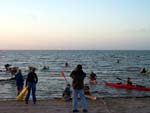 When
we recently participated in the WaterTribe’s
Everglades Challenge, a 300-mile event that takes
kayakers and small sailboaters from Tampa Bay to Key Largo,
we knew we would need good "barma." It came, in varying
amounts and sporadically, but not in quite sufficient quantity.
We wound up late to the first of the three mandatory checkpoints,
and were disqualified.
When
we recently participated in the WaterTribe’s
Everglades Challenge, a 300-mile event that takes
kayakers and small sailboaters from Tampa Bay to Key Largo,
we knew we would need good "barma." It came, in varying
amounts and sporadically, but not in quite sufficient quantity.
We wound up late to the first of the three mandatory checkpoints,
and were disqualified.
But it was an adventure anyway, which featured
great sailing and, at times, high anxiety.
We were sailing our new Jim Michalak Frolic2
design, Oaracle. New is key word here. We were still relatively
low on the learning curve for this boat. That, combined with
some unexpected weather vicissitudes, cost us too much time
on the first day of the race.
 "Oaracle" under construction
"Oaracle" under construction |
We decided to enter the race last summer after
stumbling across the WaterTribe
website. Given the available information, we realized that none
of our existing boats were suitable and decided to build the
Frolic2.
Our scheduled deadline for completion was December 31 although
thanks to flu season, the date came and went. The boat was launched
a month before the start, and we had only three sails, albeit
in strong winds (we were unreefed only part of one outing).
This expedition was also jinxed. Nothing major;
just a number of annoying things popped up during the trip,
difficulties that couldn’t be foreseen or avoided. Sort
of like a ball taking a bad hop in a baseball game. (The jinxes
stayed with us after we left the water, things on the order
of a tail light bulb falling apart, and a U-bolt bought after
much searching to make a minor trailer modification being defective....)
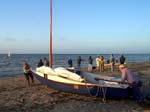 the start...
the start... |
We actually started fairly well. Boats and kayaks
must be launched at Ft. DeSoro Park on Mullet Key from above
the high water line — and the tide was nearly dead, full-moon
low. We had 3-inch PVC pipe as rollers under the boat, and managed
to move it the 20-foot or so necessary to reach the water about
30-minutes after the 7 a.m. start That includes waiting for
the kayaks to launch and clear the beach. We were behind the
new Norseboat, but ahead of the two Sea Pearls in our class.
Because of the low water and a bar only inches deep a few feet
offshore, Oaracle, its reefed sail up, had to be waded out,
soaking my jeans to the thigh.
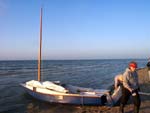 ...30 minutes later
...30 minutes later |
But the launch was achieved. We tacked offshore
to gain some room. Soon after we tacked back and headed as close
as we could to due west to clear Tampa Bay, it became apparent
something was wrong with the sail. The tie holding the throat
— the forward top corner of the balanced lug sail —
had come undone. The sail came down easily and a new tie was
installed — but, done in bouncy water, it wasn’t
quite as good. The set of the sail wasn’t quite as taut,
and it probably affected the windward ability slightly. Also
evident was a slight lee helm that had also shown up on the
test sails, but didn’t seem to affect speed or handling.
It would come back to bedevil us later.
With the sail up and having tacked back to head
out the bay, we noticed that both Sea Pearls had launched. They
were both ahead, but downwind of us as we raced out the bay
toward Egmont Key. Here came a high point for us. We overhauled
both Sea Pearls and maintained our windward position —
proof to me anyway that Michalak had designed a good boat.
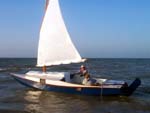 reefed
reefed |
Our glory was short lived. I tacked again about
a half mile inside Egmont and watched as both Sea Pearls headed
for the island. One tacked about a quarter mile off, the second
went almost to the beach. I concentrated on punching through
the short chop which seemed to be slowing us down. When we looked
around again, the inshore Sea Pearl had passed us and the second
was heading closer to the beach. We unreefed, which improved
our ability to punch through the chop, but we continued to lose
ground. The mistake finally dawned on me. The Sea Pearl that
went closest to shore successfully used the island to block
not only the chop, but the incoming tidal current. The second
Sea Pearl was quick to see the advantage and tack in to shore.
When I caught on, we were already past Egmont, with the full
force of the flood tide pushing us back toward the start. We
were still making progress, just not very fast. That goof put
us two hours behind the Sea Pearls getting out of Tampa Bay,
and also wasted a good, but temporary, wind shift that headed
us, but would have helped us get down the coast without tacking.
We finally cleared the mouth of the bay, and the
shoals off Anna Maria Island and headed south. The wind was
in the 10-15 mph range and we were making good progress, although
it was clear we were slowly closing the shore. (A promised westerly
wind shift never came.) We also were surprised to find a fellow
"Tribesman" in the gulf. He was in a sailing kayak
with floats attached to each side for stability. Throughout
the afternoon, we kept crossing tacks.
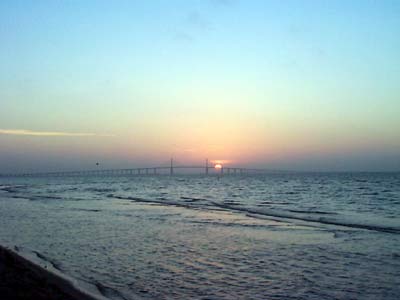
As the afternoon progressed, we made long and
short tacks, and noticed it was getting hazier. Around sunset,
we clicked on the weather radio and learned a heavy fog alert
was in force — something that was unpredicted until the
afternoon.
The wind also began to lighten, although it continued
to blow from a bit south of southwest. It was then that the
elements and the newness of the boat cost us. With the heavy
fog, our visibility was reduced to 1/4 mile, and sometimes less,
erasing the shore lights and stars I hoped to steer by. Even
worse, the fog condensed on the inside of our glasses, making
it hard to even see details in the boat. I was having a hard
time adjusting to the lee helm since all my other boats carry
the more normal weather helm. Without visual references, I kept
creeping 20 and even 30 degrees off course. Needless to say,
that didn’t help our progress.
We also wasted a couple hours poking around in
the fog seeing if we could get in Longboat Pass. Our kayaking
friend had it plotted on his GPS (I had left it off ours) and
we had him in sight. Unfortunately, we lost him in the fog,
and he had to go without us. Later, we found the entrance light
and one of the channel markers. Chart in hand, we poked slowly
in, but gave up when we could see foggy lights on shore and
no clear entrance. I wouldn’t recommend this if the sea
is up, because there are shoals that would have breakers on
either side of the entrance. But we had a shoal draft boat and
high tide, and only a foot or two of chop.
Helen went below for some rest and to get warm
from the pervading damp chill. I was on the offshore tack and
after a while decided it was time to tack back. The tiller was
thrown over, but the feeling was mush and the boat didn’t
respond. The first thought was the swinging rudder blade had
fallen off, but a quick look showed it was there. A glance over
the side showed the pivoting leeboard had raised itself into
the full up position. Although a control line can be tied off
to hold the board down, I had left it off, counting on friction
to hold it and wanting the board to raise if we hit anything.
How long had it been up? Five minutes? Ten? An hour? Longer?
There was no way to know, but we certainly made no progress
while it was up. It was a tough way to climb another notch up
the learning curve.
The wind also continued to lighten, but never
quit. But it was certainly below 10 knots and our speed slowed.
But we began to sail better if slowly in the light, shifty winds.
Helen took a long offshore tack while I took a 30-minute nap.
The night stretched on, and we got better about getting to windward.
Helen managed to get a couple naps below, while fighting off
the cold. I grabbed two 15 minute naps in addition to the 30
minute rest. Around 2:30 a.m., while Helen was below, I broke
out the Sea Swing cooker, which could be mounted in the cockpit,
and heated some water and enjoyed a cup of instant soup, followed
by a cup of hot chocolate, followed by a cup of hot cider. Things
were looking up. When Helen came back up, she got a cup of hot
coffee (a morning without coffee for Helen isn’t a morning,
it’s a catastrophe).
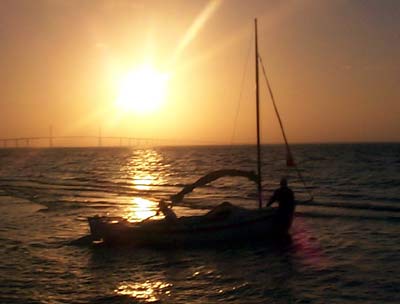
By sunrise, we were at Sarasota, but still needed
a couple tacks to get to the entrance of New Pass. By 9:30 a.m.
we were heading in, and a passing Boat/U.S. skipper gave us
directions to an anchorage. Shortly after 11, we were anchored
for some badly needed rest, and after tidying up and eating
a bit, I hit the berth about noon, and slept for two hours,
despite the rolly water.
Up at 2 p.m., I addressed some needed problems.
The forward top edge of the sail was retied to the yard, which
resulted in a better set. The traveler for the two-part sheet
was moved aft, where it didn’t occasionally interfere
with the tiller when tacking. The line that controls the outhaul
and downhaul of the boom was set better, and overall, we got
a much better looking set of sail than the first day. We were
definitely climbing the learning curve.
Raising anchor at 3 p.m., we faced a tough choice.
We only had 21 hours to make it to the first checkpoint, and
we were, at best, only halfway there. Despite the nap, there
was also no question we would need to stop again to get a decent
night’s rest. Our chances didn’t look good, but
we didn’t want to give up. Rather than sail out Big Sarasota
pass (where we might have to do some beating) and then back
in Venice Pass a few miles down the coast, we decided to try
the Intracoastal Waterway. It looked like a mile or so of narrow
going, with the waterway then widening out into Little Sarasota
Bay almost the entire way to Venice.
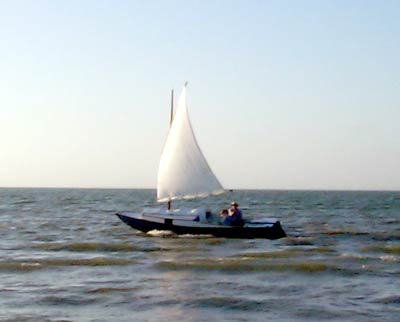
It went well, partly because the wind had finally
backed to the west and no tacking was necessary, but mostly
because we got in the groove. When the channel was narrow and
trees or buildings blocked the breeze, I rowed. But mostly we
were able to keep sailing. The only downside was the powerboat
wakes — 40 and even 50 foot boats thought nothing of blasting
by a few feet away, throwing steep wakes. We felt sorry for
the Watertribers who were kayaking that route. (We actually
passed one resting competitor, who came dashing out into the
shoal water to wish us well and tell us he was waiting for night,
when there would be fewer wakes.)
When we hit little Sarasota Bay, the water widened
and the wind became steady. We headed down the channel as though
on a magic carpet, doing a steady 3-4 knots. In the waning afternoon,
even the powerboat traffic became less.
Our balanced lug rig was short enough to make
it under most of the drawbridges, but a high point for Helen
came when she radioed an upcoming swing bridge and the operator
called her "Skipper" on the return call. The bridge
open promptly, and a bemused sounding operator came out as we
drifted through to ask the boat’s name.
We made it to Venice Inlet around 9 p.m. and slipped
behind a mangrove island to anchor in a natural, tide scoured
channel. We had dinner, some hot drinks, and I called my brother
to give a position report that he forwarded to the race organizers.
We were almost 25 miles, as the crow flies, from Checkpoint
1, and we had to be there by noon. On the other hand, the weather
forecast was for strong northwest winds, which would help. After
tidying up, we got to bed around midnight, with the alarm set
for 5:30.
At the 5:30 a.m. alarm, I poked my head into the
dark. The second of two predicted cold fronts was apparently
passing through, with great gusto. Winds were well over 20 with
gusts that seemed near 30. Too much for an early departure.
I went back to bed. At 7 a.m., winds had fallen back into the
moderate range. We got up, had breakfast. Shortly after 8, the
anchor was up and we were away under full sail. Our chances
were now next to none, but I figured if we got there by 1:30,
I could declare a weather hold (allowed under Watertribe rules)
to account for the morning’s high winds. We meandered
around the mouth of the Venice Inlet, and headed down the waterway
After about a half mile, we hit a manmade section, about 150-200
feet wide, with 15 to 20 foot banks on both sides. I was worried,
even with the wind mostly behind us that we would wind up rowing
a lot. But the wind, although light for about a mile of the
course, never failed and we made steady progress. A mere two
hours and 20 minutes after lifting anchor, we had sailed from
behind our mangrove island, up to the narrow channel, and through
five to six miles of channel, to the start of Lemon Bay.
At Lemon Bay, things began to pick up. No longer
partly blocked, we had free wind and our speed passed four and
settled around 5 knots. A couple miles down the bay, we were
passed, slowly, by three sailboats in the 25-foot range, all
under power. About a half hour later, as the winds increased,
we passed them under sail. A mile or so on, it became clear
a reef was needed. Oaracle is a light, but strongly built boat,
but I was worried about pushing the rig too hard, even though
every thing seemed to be holding together fine and we were averaging
about 6 knots. We pulled out of the channel, behind an island,
dropped anchor and then the sail and reefed. Helen wondered
if we should double reef, and I should have listened. But with
one reef, the boat felt under better control, and our speed
was not diminished at all. At the end of Lemon Bay, the waterway
constricted, and the boat slowed a bit as the winds were slightly
blocked, As we squirted out into Gasparilla Sound, the unfettered
wind, stronger than ever blasted us the last mile or so to the
Boca Grande causeway swing bridge. I glanced at my watch —
it was 2:15 p.m. We were too late and still had to get up a
difficult creek to reach the checkpoint. But I was proud of
how the boat and we performed that morning. The GPS had put
us 24 to 25 (land) miles from this point when we had started,
just under six hours earlier. And that didn’t account
for zig-zags on the Intracoastal and our pause to reef, although
on the plus we had had a favorable tide at the start.
I felt we had finally hit the groove the previous
afternoon and during that last day. We handled what came our
way, kept the boat moving, kept ourselves fed and in good shape
and made good progress. Our poor start had doomed us. But although
we were hurt by nagging boat problems, a couple of my poor decisions
and bad luck on the first day, by the second we had sorted out
the boat and from thereon kept it moving well. Although we were
out of the race this year, we had acquired the skills and knowledge
to finish.
Unfortunately, there was still a little more to
learn and we did it the method I usually do it – the hard
way. We called the Boca Grande swing bridge operator to request
the bridge open, and learned they do it on a schedule —
every 15 minutes as it turned out, and the next opening was
15 minutes away. The wind was blowing a steady 20 or so, with
gusts near 30. The course we had to take to the checkpoint took
us under the bridge, past a nearby abandoned railroad bridge
(with a section permanently removed for the waterway), then
down a side channel and then up a creek into a mangrove area
to a kayaking rental and sales shop. The chart indicated plenty
of water up the side channel, but with shoals on either side.
I was worried because I had no local knowledge and at the speed
we were moving, there would be little time for error. I figured
the conservative thing to do was drop the sail and mast and
row the rest of the way After all, it would be downwind past
the first two bridges, and then we should get a lee from at
least some of the wind.
The idea was sound but my execution was poor.
We reached out of the channel to be clear of traffic (and our
speed, which felt around six knots went to around eight). We
rounded up into the wind and the sail and mast came down quickly.
But still unfamiliar with Oaracle’s handling, I had miscalculated
how fast we would drift downwind toward the island that held
the causeway west of the bridge. By the time the rig was stowed
and the oars were out, we were too close to the island to row
back to the bridge, and there was no way to row into that gusty
wind. I hopped out and held Oaracle off and we made an ad hoc
landing on the sandy beach. There was no choice but to walk
the boat a half mile or so to the far side of the island and
try and go under the bridge there — the close side was
impassable because of a bulkhead and deep water there. We would
have been blown into the bulkhead before we could row clear.
Once under the bridge, the causeway island blocked most of the
wind, and we were able to row back toward the main channel fairly
easily, me at the oars and Helen helping keep course by steering.
We got by the railroad bridge, and found the right side channel
with little trouble, although the wind kept blowing us sideway
out of the narrow channel into the shallow water. We finally
headed up the creek to a fixed highway bridge and more bad luck.
The race organizer had warned the pilings were only about 12
feet apart, but another competitor said they were wider. Oaracle
rows with seven-foot oars, which means we needed 14 feet of
horizontal clearance. We got to the bridge and it was obvious
we were well short of the required width. We attempted to get
through with Helen in the front and me in the back, pulling
ourselves through using the pilings, but both the wind, even
though now partially blocked, and the tide were against us.
I rowed hard, but only got the nose of the boat under the bridge
before I had to haul in the oars. The boat quickly stopped and
drifted backwards. There was no choice but to head to the shore
where the water was knee to thigh deep, and get out and walk
the boat under the first span, crunching over oyster bars. If
you’re going to do this, make sure you have a heavy pair
of boots. I got mine at a commercial fishing chandlery and they
took the abuse without complaint, and more importantly, without
injury to my feet.
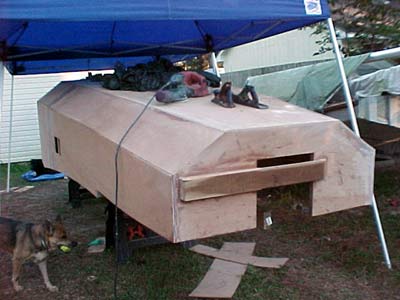
Once past that bridge, waiting was another open
section of the abandoned railroad bridge. There was just enough
room to row by, with pilings and the old bridge on one side
and underwater pilings just below the surface on the other.
Hard rowing beat the current and wind, and after that it took
about 15 minutes, with the wind still trying to blow us back,
to get to checkpoint 1. I was so tired when we got in, I forgot
to check my watch. Some time later, I looked at it, and it was
after 5 p.m., and I surmised we got in sometime around 4:30.
The hard won local knowledge gained from this
was that I should have left the sail up and waited 15 minutes
for the swing bridge. We would have been to the end of the side
channel under sail in another 10 minutes, and could have anchored
to drop the sail and mast. Getting under the fixed bridge would
still have been a hassle, but I would have been fresher. The
total time to the checkpoint from the swing bridge would have
been no more than an hour, instead of the more than two hours
we wound up taking.
One of the reasons for doing things like a Watertribe
challenge is how much you learn, both about specific areas and
about sailing in general. (And let me say here none of our difficulties
should be attributed to the boat. It performed superbly and
did everything we asked, and more. The shortcomings were in
our ability to get the most out of it, and our insufficient
knowledge with its strengths and weaknesses.)
What did we learn?
1. More preparation time would have eased many
of our problems. I had hoped to have two full months sailing
the boat, including at least one overnight trip, before the
race. For reasons noted above, that proved impossible. That
hurt probably the most on the first day as we were still learning
how best to sail the boat — and trying to do it in a heavy
fog at night with our glasses continually misting up.
2. Additional preparation extends to planning.
I needed more time going over charts getting familiar with the
unknown coast and waterways, but didn’t have the time.
3. Always be thinking ahead and planning for contingencies.
By the second and third day, we were doing that well, although
I blew it deciding to row at the final swing bridge. The decision
wasn’t all that bad, but the catch was I didn’t
know how fast the boat would drift down wind — that inexperience
with a new craft again.
4. If time permits, get as much local knowledge
as possible. If we do another challenge, I’ll make every
effort to at least explore the waters around the checkpoints.
Knowing what difficulties lie ahead is the best way to be able
to prepare for them. For example, next time at Checkpoint 1,
I’ll have an oarlock on the back of the boat for sculling
and will make every effort to catch a favorable tide under that
one bridge.
5. Do what’s necessary to take care of yourself.
Helen has Rosacea, and prolonged exposure to the cold, wind,
and sun creates havoc with her skin. She used her lotions and
eyedrops, but her lower lip was still badly affected and blistered
after we left the water. Also on the first night, we both failed
to put on the long underwear we had brought. It wasn’t
all that cold, but the damp fog was penetrating after being
in it for a prolonged period of time. I got chilled, and Helen
got the shivers a couple times. Fortunately, Oaracle has a cosy
cabin with high density foam cushions beneath warm bedrolls
waiting for an off watch member. I stress high density foam,
since it proved to provide an excellent foundation for great
sleeping. We both awoke feeling refreshed and were ache free
from the rest.
What went right? The boat. Oaracle proved to be
a wonderful craft for this event. Lighter than a Sea Pearl,
it’s easier to launch off the beach, yet offers a ready
cabin for shelter and a comfortable cockpit, with bench seating.
One change we’re considering is adding a small mizzen.
It would correct the lee helm, if we can’t tune that out
(there are other ways without adding an additional sail), and
it would give us an instant way to heave to, which would help
when reefing or unreefing, or just to take a break. The first
night, for example, we could have hove to on the offshore tack
and gotten some much needed rest, probably enough to keep going
through the second day, which would have put us at Checkpoint
1 on time.

